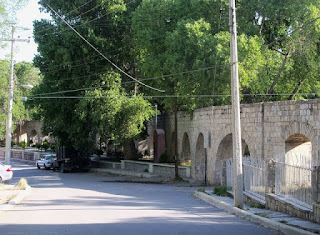As the desert turns an ever deepening shade of brown, I thought it would be good to reflect on the miraculous water of Parras de la Fuente and particularly Hacienda de Perote. Its source is wrapped in even more mystique than the Virgin of Guadalupe.
If you ask 50 Parrasians where the water originates, you may get as many as 50 different answers. Most of them are variations of three themes.
One: The water comes from the Atlantic Ocean.
Two: An underground river runs straight from Lake Chapala outside Guadalajara to the springs above Parras.
Three: The springs are fed from a deep underground lake that no one has ever located.
So .. . there you have the legend(s).
Here is what the scientists say: Very little that is available to me.
However, since themes one and two violate the first law of water: WATER FLOWS DOWNHILL - it seems reasonable that the explanation is some variation of the third theme. There must be an underground aquifer which is recharged by the rain water collected in the mountains to the south of Parras. The water must be funneled through the formations within the mountains through cracks and fissures, caverns and splits to the many natural springs above the town.
The source of the water may be difficult to visualize, but once it hits the air, it is easy to track. Years ago, huge tanks - tanques - were built at each of the major springs to capture and store the water to be released as needed. Then came high volume, shallow-water pumps that bring about 200 gallons a minute to the surface. With the pumps pulling so much water to the surface, the volume of water naturally flowing into the tanks diminished and many of them have now been abandoned.
Several still survive. One of the best known is Tanque de la Luz which was built as a reservoir to control the volume of water needed to run the turbines to produce luz - electricity. Edison came to Parras to help facilitate the production of hydro-electric power supposedly making Parras the first community in all of Mexico to experience a world lit by electricity.
Today, Tanque de la Luz is a multi-purpose facility. Tourists flock there in the summer to swim, picnic, sunbathe, and hang out with friends and family. It is also one of several municipal tanques still used for the capture and release of water for agricultural purposes.
As you walk around town, you are never far from water. In the old days, it was carried in aqueducts, some of which are still standing.
Now, it travels along the streets in narrow canals. Municipal water wardens open and close gates on these canals to make sure everyone gets a fair share. It allows almost all property owners to have a small pecan grove, vineyard, or garden.
Beyond the city limits, you can follow the water as it makes its way in a canal beside the highway to Paila. Even with careful monitoring, the water will only stretch so far. Several miles to the north of Parras, the water disappears and the green of the Parras oasis gives way to the brown of the Chihuahuan Desert.
The agricultural focus of the Parras area has shifted many times over the years. Grapes, wheat, corn, alfalfa, vegetables, melons, cattle, olives, and cotton have dominated the scene from time to time. Today, the major crop is pecans which require as much as one to two meters of water across the roots of the tree during the course of the growing season. Since we have very little rainfall, the vast majority of that water comes from the aquifer - either by natural springs or pumping.
Hacienda de Perote, a major pecan growing facility, has its own water source.
Our water seeps out of the ground in a formation which doubles as the Bat Cave. Home to several hundred Mexican Free-Tail Bats, our water is not only wet, but naturally enriched with bat guano. That may put a damper on using it as drinking water, but the plants love it. Seemingly unaffected by the seasons, the water continually runs out of the mouth of the cave;
around a bend;
and into a large 40,000 gallon tanque less than 100 yards from our front door.
During the growing season, the water is generally released in the morning. It follows an intricate maze of channels to the always thirsty pecan trees. During this period of heavy usage, the natural flow from the bat cave is supplemented with water pumped from a shallow well. With both the natural flow and the pumped water, the tanque is refilled by the next morning.
When the trees are not actively growing, the spring water is used in the hacienda gardens and the pumps are turned off.
Water for our personal gardens and vineyards comes through this siphon hose placed in the channel right outside the tanque. Our water supply is constant, unless of course, someone pulls the hose out of the channel.
That one-inch piece of tubing allows us to grow almost anything we want: vegetables, fruit trees, grapes, herbs, and roses.
The mystical waters of Parras turn a piece of brown desert into lush pecan groves,
restful gardens,
and productive vineyards.
Those mystical waters have made our time here a time of wine and roses and all things beautiful!












